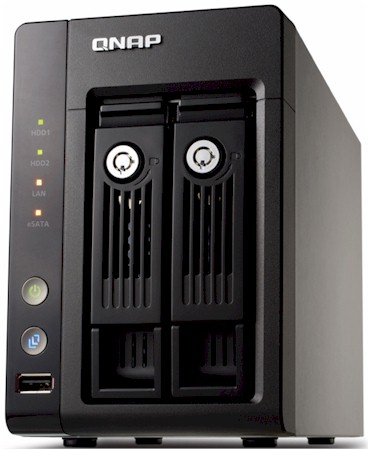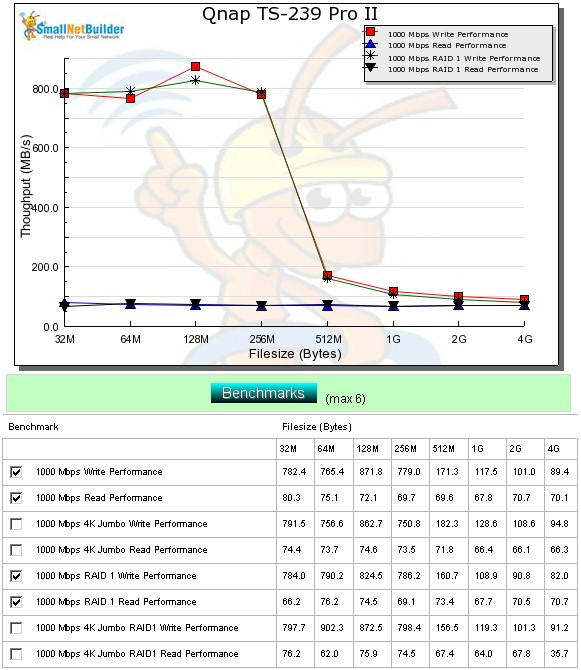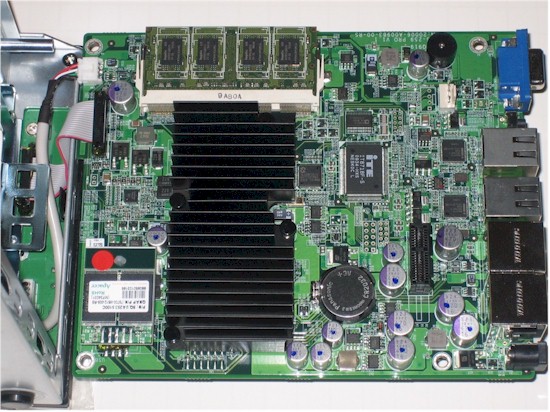The QNAP TS-239 Pro II has been added to the NAS Charts. QNAP again establishes new highs for dual-drive NAS performance.
The 239 Pro II is an updated version of QNAP’s TS-239 Pro using an Intel D410 Atom @ 1.66 GHz CPU vs. an Intel Atom N270 @ 1.6 GHz. Memory stays the same at 1 GB, but flash has expanded to 512 MB from 128 MB.
Two 2.5" or 3.5" SATA hot-swappable drives (the drive trays have mounting holes for both) in capacities up to 2 TB are configurable in separate, JBOD, RAID 0 and RAID 1 volumes and RAID expansion and migration are supported. Internal volumes can be formatted in EXT3 or EXT4.
The 239 Pro II runs Version 3.2 of QNAP’s Linux-based OS, which adds support for IPv6, Apple Time Machine backup, Backup to Amazon S3 Cloud Storage, DFS Folder Aggregation and WebDAV. Also included are iSCSI enhancements including SPC-3 Persistent Reservation, MC/S & MPIO and compatibility with VMware vSphere 4.x.

QNAP TS-239 Pro II
As mentioned above, the 239 Pro II uses an Intel Atom D410 @ 1.66 GHz and has a 1 GB SODIMM of DDR2 667 RAM. The OS resides in a 512 MB IDE DOM (Disk on Memory). Other details visible in the photo below are two Intel 82574L Gigabit Ethernet Controllers and an ITE IT8718F "Super I/O". The 10/100/1000 Ethernet ports support up to 9K jumbo frames and can be configured in separate, failover and aggregation modes.
QNAP TS-239 Pro II board
Rear panel connectors include two 10/100/1000 Ethernet ports, two eSATA connectors and five (up from three) USB 2.0 ports for drive expansion and attached backup. The USB ports also support UPS shutdown sync and printer sharing. There is also a 15 pin video connector, for console display. Root access via direct-attached console, SSH and Telnet is supported.
Power consumption measured 35 W with two Samsung HE103UJ 1 TB 3.5" drives provided by QNAP and 17 W with the drives spun down via the programmable idle time (between 5 and 60 minutes of inactivity). Shutdown, startup and restart can also be scheduled daily, weekly on the weekend or on specific days.
Fan and drive noise are medium low, meaning the NAS is noticeable in a quiet room. The main noise sources are the drives themselves (including drive clicks and thunks) and some occasional cabinet rattle.
CIFS/SMB, AFP and NFS network file systems are supported, and files can also be accessed via FTP and secure (SSL/TLS) FTP. HTTPS is supported for admin access. Up to eight iSCSI targets can be configured and the NAS also can act as an iSCSI initiator.
Media features include iTunes and UPnP AV / DLNA 1.5 (Twonkymedia) servers and there is a download service for HTTP, FTP and BitTorrent files. The full set of QNAP features are supported including photo web serving, surveillance camera recording and LAMP webserving.
Immediate and scheduled backup can be done to an attached USB or eSATA drive or via rsync to networked rsync targets. External drives can be formatted for read and write in FAT32, NTFS, EXT3 and EXT4.
The 239 Pro is a suprisingly fast NAS, whether used as an SMB / CIFS share or iSCSI target. RAID 1 write performance with a Gigabit LAN connection averaged 93.9 MB/s for file sizes between 32 MB and 4 GB, with cached behavior not included in the average calculation. Read performance was slightly lower, measuring 71.1 MB/s with the same conditions. Both results put the 239 Pro II at the top of the RAID 1 charts.
The summary of the iozone benchmarks in the plot below show very high cache boost up to file sizes of 256 MB, with effects not really dropping out until 1 GB. RAID 1 doesn’t seem to impose much of a performance hit and using 4K jumbo frames doesn’t provide any more of a performance boost than it does with other NASes, i.e. none.

QNAP TS-239 Pro II iozone performance results
File copy performance using a Vista SP1 client under the same conditions (RAID 1, Gigabit LAN) also established new chart highs for dual-drive NASes at 75.8 MB/s for write and 87.8 MB/s for read.
File copy to a 10 GB portion of a RAID 0 volume configured as an iSCSI target measured 71.4 MB/s for write and 67.0 MB/s for read. This is a bit better for write than the 239 Pro and about the same for read.
QNAP’s 3.2 firmware has removed the performance penalty seen in other NASes when using NTFS-formatted drives for backup. This, plus the D410 Atom platform, resulted in similar backup speeds to an Iomega UltraMax Pro Desktop drive target configured in RAID 0 using our ~ 4 GB standard filecopy test folder. The highest speed of 89.28 MB/s was achieved using eSATA and NTFS (!) format. Attaching the Iomega drive via USB yielded speeds in the 24 to 27 MB/s range.
QNAP NAS features have been well-explored in other QNAP reviews, so a full review isn’t planned. Don’t forget to compare performance (including backup) using the NAS Charts.

